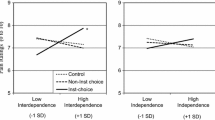Abstract
Participants who reported either low or high self-efficacy for tolerating painful stimuli were randomly assigned to conditions, in which they either did or did not have a choice of strategies for coping with arm shock. Choice and self-efficacy were positively associated with increases in perceived control. Being given a choice, in comparison to having no choice, led to increased tolerance of arm shock and lower pain reports for those with high self-efficacy. Providing a choice of strategies did not benefit those with low self-efficacy. This study demonstrates that the benefits of allowing individuals the opportunity of choosing among an array of coping options depend on a prior conviction that one is able to cope.
Similar content being viewed by others
REFERENCES
Ajzen, I., and Madden, T. J. (1986). Prediction of goal-directed behavior: Attitudes, intentions, and perceived behavioral control. J. Exp. Soc. Psychol. 22: 453–474.
Altmaier, E. M., Russell, D. W., Kao, C. F., Lehmann, T. R., and Weinstein, J. N. (1993). Role of self-efficacy in rehabilitation outcome among chronic low back pain patients. J. Counsel. Psychol. 40: 335–339.
Averill, J. R. (1973). Personal control over aversive stimuli and its relationship to stress. Psychol. Bull. 80: 286–303.
Baker, S. L., and Kirsch, I. (1991). Cognitive mediators of pain perception and tolerance. J. Pers. Soc. Psychol. 61: 504–510.
Bandura, A. (1997). Self-efficacy: The Exercise of Control. W. H. Freeman, New York.
Bandura, A., Cioffi, D., Taylor, C. B., and Brouillard, M. E. (1988). Perceived self-efficacy in coping with cognitive stressors and opioid activation. J. Pers. Soc. Psychol. 55: 479–488.
Bandura, A., O'Leary, A., Taylor, C. B., Gauthier, J., and Gossard, D. (1987). Perceived self-efficacy and pain control: Opioid and nonopioid mechanisms. J. Pers. Soc. Psychol. 53: 563–571.
Bowers, K. S. (1968). Pain, anxiety, and perceived control. J. Consult. Clin. Psychol. 32: 596–602.
Butler, R. W., Damarin, F. L., Beaulieu, C., Schwebel, A. I., and Thorn, B. E. (1989). Assessing cognitive coping strategies for acute postsurgical pain. Psychol. Assess. 1: 41–45.
Council, J. R., Ahern, D. K., Follick, M. J., and Kline, C. L. (1988). Expectancies and functional impairment in chronic low back pain. Pain 33: 323–331.
Glasgow, R. E., Klepac, R. K., Dowling, J., and Rokke, P. D. (1982). Measures of self-efficacy in pain tolerance. Paper presented at the Annual Association for Advancement of Behavior Therapy Convention, Los Angeles.
Gross, P. R. (1992). Is pain sensitivity associated with dental avoidance? Behav. Res. Ther. 30: 7–13.
Jensen, M. P., Turner, J. A., and Romano, J. M. (1991). Self-efficacy and outcome expectancies: Relationship to chronic pain coping strategies and adjustment. Pain 44: 263–269.
Keppel, G. (1973). Design and Analysis: A Researchers Handbook. Prentice-Hall, Englewood Cliffs, NJ.
Litt, M. D. (1988). Self-efficacy and perceived control: Cognitive mediators of pain tolerance. J. Pers. Soc. Psychol. 54: 149–160.
Litt, M. D., Nye, C., and Shafer, D. (1995). Preparation for oral surgery: Evaluating elements of coping. J. Behav. Med. 18: 435–459.
Melzack, R. (1975). The McGill Pain Questionnaire: Major properties and scoring methods. Pain 1: 277–299.
Miller, S. M. (1979). Controllability and human stress: Method, evidence and theory. Behav. Res. Ther. 17: 287–304.
Moe, K. O., and Zeiss, A. M. (1982). Measuring self-efficacy expectations for social skills: A methodological inquiry. Cogn. Ther. Res. 6: 191–205.
Paterson, R. J., and Neufeld, R. W. J. (1995). What are my options? Influences of choice availability on stress and the perception of control. J. Res. Pers. 29: 145–167.
Rokke, P. D., and al'Absi, M. (1992). Matching pain coping strategies to the individual: A prospective validation of the Cognitive Coping Strategy Inventory. J. Behav. Med. 15: 611–625.
Rokke, P. D., Al Absi, M., Lall, T., and Oswald, K., (1991). When does a choice of coping strategies help? The interaction of choice and locus of control. J. Behav. Med. 14: 491–504.
Rokke, P. D., Carter, A. S., Rehm, L. P., and Veltum, L. G. (1990). Comparative credibility of current treatments for depression. Psychotherapy 27: 235–242.
Rokke, P. D., and Lall, R. (1992). The role of choice in enhancing tolerance to acute pain. Cogn. Ther. Res. 16: 53–65.
Staub, E., Tursky, B., and Schwartz, G. E. (1971). Self-control and predictability: Their effects on reactions to aversive stimulation. J. Pers. Soc. Psychol. 18: 157–162.
Williams, S. L., and Kinney, P. J. (1991). Performance and nonperformance strategies for coping with acute pain: The role of perceived self-efficacy, expected outcomes, and attention. Cogn. Ther. Res. 15: 1–19.
Author information
Authors and Affiliations
Rights and permissions
About this article
Cite this article
Rokke, P.D., Fleming-Ficek, S., Siemens, N.M. et al. Self-Efficacy and Choice of Coping Strategies for Tolerating Acute Pain. J Behav Med 27, 343–360 (2004). https://doi.org/10.1023/B:JOBM.0000042409.81856.5c
Issue Date:
DOI: https://doi.org/10.1023/B:JOBM.0000042409.81856.5c




